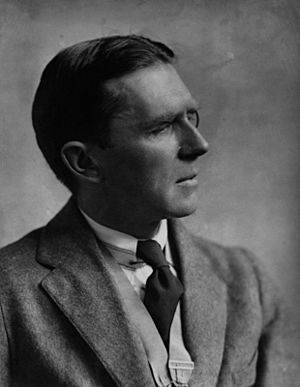Patrick Abercrombie facts for kids
Quick facts for kids
Sir Patrick Abercrombie
|
|
|---|---|
 |
|
| Born |
Leslie Patrick Abercrombie
6 June 1879 Ashton upon Mersey, Cheshire, England
|
| Died | 23 March 1957 (aged 77) Aston Tirrold, Berkshire, England
|
| Occupation | City planner |
| Spouse(s) |
Emily Maud Gordon
(m. 1908; died 1942) |
| Children | 2 |
Sir Leslie Patrick Abercrombie (/ˈæbərkrʌmbi, -krɒmbi/ ab-ƏR-krum-BEE-,_--KROM-bee; 6 June 1879 – 23 March 1957) was a famous English town planner. He helped design cities and regions. For most of his life, Abercrombie was a professor. He created plans for one city and several regions before World War II. He became very well known in the 1940s. He made important plans for cities like Plymouth, Hull, Bath, Bournemouth, Hong Kong, Edinburgh, and Greater London.
Contents
Early Life and Education
Patrick Abercrombie was born in Ashton-upon-Mersey, England. He was one of nine children. His father, William Abercrombie, was a businessman who loved art. In 1887, his family moved to a new home in Sale. This house was designed by an architect named Joseph Goddard. Patrick went to Uppingham School. He also spent a year studying in Lucerne, Switzerland.
Career in Planning
In 1897, Patrick Abercrombie began training as an architect. He worked for Charles Heathcote and studied at the Manchester School of Art. Later, he moved to Liverpool and worked for Arnold Thornely. In 1907, he started teaching at the University of Liverpool School of Architecture.
In 1914, he won a competition for a town planning design for Dublin. The next year, he became a professor at Liverpool. He quickly became a national expert in town planning. He also studied the garden city movement, which focused on creating green, planned communities.
Later, he became a professor at University College London. He became famous around the world for redesigning cities. These included Plymouth, Hull, Bath, Edinburgh, and Bournemouth. After World War II, many cities needed to be rebuilt. His plans for Plymouth, for example, aimed to create a modern city. Some people felt these new concrete buildings changed the historic feel of the old areas.
In the 1920s and 1930s, Abercrombie became an expert in planning large regions. He led the Council for the Preservation of Rural England. This group worked to protect the countryside. He also served as President of the Geographical Association in 1937. His speech was about how geography is important for planning.
Planning for London
Abercrombie is most famous for his plans to rebuild London after World War II. In 1943, he created the County of London Plan. In 1944, he published the Greater London Plan. These two plans are often called the Abercrombie Plan.
The Greater London Plan suggested that London should stop growing outwards. It proposed a green belt around the city. This green belt would be an area of open land where building was restricted. The plan also suggested that over a million people should move from London to new, expanded towns outside this green belt. Abercrombie also thought of a system of four ring roads around London.
In 1945, he worked on a plan for the city of Kingston upon Hull. This plan was not accepted by the city leaders.
New Towns Movement
The Abercrombie Plan led to the New Towns movement. This meant building completely new towns. Examples include Harlow and Crawley. He also helped plan Harold Hill, a large housing area in London.
In 1946, he created the Clyde Valley Regional Plan. This plan suggested building new towns like East Kilbride and Cumbernauld in Scotland. In 1949, he published a plan for Warwick. This plan suggested tearing down many old Victorian houses and building a large road around the town center.
International Projects
After the war, the British government asked Abercrombie to redesign Hong Kong. He submitted his plans in 1947. In 1956, Haile Selassie, the emperor of Ethiopia, asked him to plan the capital city, Addis Ababa. Abercrombie submitted his plan in 1957, but most of it was not built.
Awards and Legacy
Patrick Abercrombie was made a Knight Bachelor in 1945. This means he was given the title "Sir." He was the most celebrated British planner of his time. In 1948, he became the first president of the International Union of Architects (UIA). This group now gives out the Sir Patrick Abercrombie Prize every year for excellent town planning. In 1950, he received the AIA Gold Medal, a top award for architects.
The Abercrombie Building at Oxford Brookes University is named after him. It houses the Faculty of Technology, Design and Environment. He also appeared in a film called The Proud City, where he presented his plan for London.
Sir Patrick Abercrombie passed away in 1957. A blue plaque marks a house where he lived from 1915 to 1935 in Oxton, Merseyside. He also designed the North East Wales Institute of Higher Education (NEWI) in Wrexham.
Family Life
Patrick Abercrombie married Emily Maud Gordon in 1908. They had one son and one daughter. His wife passed away in 1942. Patrick was the brother of the poet Lascelles Abercrombie. He was also the uncle of Michael Abercrombie.
See also
In Spanish: Patrick Abercrombie para niños

